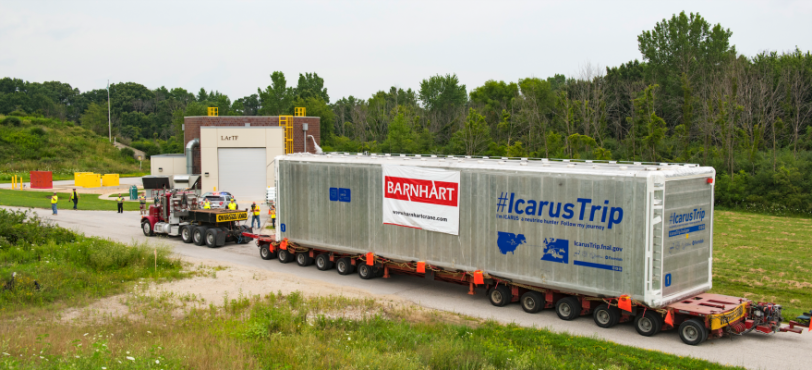SBN and ICARUS
Short Baseline Neutrino program
Short Baseline Neutrino (SBN) program looks for possible neutrino oscillation at the short baseline (L/E ~ 1m/MeV) using a muon neutrino source from the Booster Neutrino Beamline (BNB) at Fermilab. In order to quantify the oscillation effect precisely, the SBN program employs two detectors: the Short Baseline Near Detector (SBND) measures unoscillated neutrino flux and the ICARUS far detector is placed near the location where a hypothesized oscillation maximum is expected. Both SBND and ICARUS use the same Liquid Argon Time Projection Chamber (LArTPC) technology to detect neutrinos. The MiniBooNE anomaly events in the low energy region (see MicroBooNE experiment) is one of core drivers for this hypothetical oscillation in the short distance, and the SBN program operates on the same beamline as the MiniBooNE. The MicroBooNE LArTPC detector, placed just in front of the ICARUS detector along the BNB beamline, is currently operational and will also participate in the SBN program for a combined data analysis.

ICARUS
The ICARUS collaboration has pioneered and developed the liquid argon projection chamber concept since its inception. This effort went through increasingly larger prototypes and culminated in the cosmic ray detection experiment in Pavia with a 300 tonne detector module, and with a neutrino detection experiment at LNGS using two twin 300 tonne modules and the CNGS neutrino beam from CERN. The same two modules have been updated and moved to Fermilab to participate in the SBN program. Our group at SLAC take a number of core roles in the installation, operation, and data anaysis of the ICARUS detector as well as the near-far combined oscillation analysis for the whole SBN program.

Big Detector = Big Data
The Giga-Pixel-per-Second Imaging: The ICARUS LArTPC contains about 60,000 readout channels where each records a waveform of 4,096 samples when a readout trigger is issued (e.g. when there may be a neutrino interaction). That is an image of 240 mega-pixels. BNB neutrinos are pulsed at about the rate of 5 Hz, and the accelerator complex sends an early warning signal to all SBN detectors so that each detector can issue a readout trigger at accurate timing. If we are to record all neutrino beam pulses, the data rate exceeds 1 giga-pixels/second which is too big to handle for both data taking and offline data analysis.
DAQ and Trigger: the data acquisition (DAQ) and trigger systems are two crucial components for data taking. While the beam comes at 5 Hz, only about 1% of them are expected to interact in our detector, and they can be detected using 360 Photo-Multiplier Tubes (PMTs). The trigger system can drastically reduce the data readout rate while keeping all neutrino events using PMT hit pattern and the time coincidence with the BNB early warning signal. Further, data compression algorithms are implemented in the DAQ system, which consists of dozens of server computers simultaneously reading data from 60,000 channels, in order to reduce individual image size by a fctor of 5 without loss of information.
SLAC group has taken critical roles developing both the DAQ and trigger systems of the ICARUS detector. We have been actively participating in the ICARUS detector installation and commissioning activities in order to deliver a stable operation and high quality data taking.

Physics Modeling and Inference
Physics modeling: is to simulate experimental data based on the knowledge of particle physics, incoming neutrino flux, and the detector response. Hving a simulation software is vital at all stages of an experiment including the design optimization, sensitivity study (to physics signal), and inference of target physics parameters from collected data. Two challenging aspects of simulation in the SBN program are a modeling of neutrino-nuclear interactions and the detector response. Accurate modeling of those require deeper understanding of real data collected in the experiments.
Physics inference: is to infer the physics models and parameters behind from the experiment data or simulation. In case of LArTPCs, this means to infer the flavor and energy of a neutrino, or ultimately neutrino oscillation parameters, from high resolution images of charged particle trajectories. While these images are visually intuitive to analyze, an automated, high quality data reconstruction chain is needed to process millions of images. The development of a data reconstruction software is an active area of research, and rapid progress has been made recently incorporating machine learning techniques from the field of computer vision.
SLAC group leads overall software integration effort as well as algorithms development at all stages of simulation and data reconstruction. Our members lead machine learning efforts in ICARUS and SBN program for a data reconstruction chain, uncertainty quantification, and mitigation of data v.s. simulation domain discrepancies.

